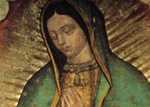Juan Diego (1474 - 1548)/ La Virgen de
Guadalupe
1474 – 1548 This Aztec man's birth name was Quauhtla
Tóhuac. His name means "he who speaks like an eagle" or "talking
eagle".
He
was born in Cuautitlán north of Tenochtitlán in the Aztec Empire. He was a
native Náhuatl-speaking Mexica who lived in a village near a hill not far from
Tenochtitlán (currently, part of Mexico City). Before the arrival of the
Spaniards in 1519, he was a farmer and vendor of sleeping mats. His village was
called Tolpetlac (or Tlayacac), near the current Villa de Guadalupe.
Alternatively, he was known as Juan Diegotzil. He was beatified by the Roman
Catholic Church in 1990, and he was canonized in 2002 as San Juan Diego
Quauhtlatoatzin.
1519 – 1521 The Spaniards under the command of Hernán
Cortés conquer Tenochitlán, thereby destroying the Aztec empire and replacing
the Aztecs as the new rulers of Mesoamerica.
1521 – 1531 At some unknown date (possibly 1524 or 1525)
after the Spanish conquest of his town and the entire region, Quauhtla Tóhuac
and his wife was converted to the Roman Catholic religion. In addition to
converting to Christianity, he was taught Spanish. When he was baptized his
name was changed to Juan Diego.
1529 Juan Diego's wife, baptized as María Lucía, died. The
couple had lived in chastity for a couple of years before she died.
1531 Between
December 9, 1531 and December 12, 1531, according to Juan Diego and Catholic
tradition, Santa María (Virgin Mary) appeared to Quauhtla Tóhuac / Juan Diego
three times. For an image of the original canvas depicting Nuestra Señora de
Guadalupe (Our Lady of Guadalupe), click on the following photo fragment:
The
miraculous appearances took place on the Cerro de Tepeyac (Tepeyac Hill).
Tepeyac had been the place where the Aztecs had erected a shrine to the goddess
Tonantzin. This goddess was considered the mother of the gods; she was depicted
as a young woman in a white tunic; Tonantzin is understood to have been a
pre-Aztec lunar goddess.
The
lady spoke to him in Náhuatl and called him "Xocoyte" (little son). He answered in
Náhuatl.
After
each miraculous visitation, Juan Diego made a visit (3 visits in all) to the
Bishop of México, Juan de Zumárraga. At each visit, Juan Diego gave a message
to the bishop, which was that the bishop should build a church on Tepeyac Hill.
First
visit: it ended in failure. Juan Diego had begged the Virgin to send a
messenger who was more important than he. The strange lady asked him to tell
the bishop to build a small house or
chapel (teocalli) on the hill. The
bishop wanted proof in the form of a sign that Juan Diego really had spoken to
the Virgin Mary. So he even tried to avoid the Virgin. Meantime he went
searching for a priest to attend to his dying uncle. According to pious
tradition, the Virgin cured Juan Diego's uncle thereby removing his excuse for
not going back to see the bishop.
Second
visit: likewise a failure. Later that day the lady told him she would give him
a sign.
Third
visit: on Tepeyac Hill Juan Diego picked fresh roses, which in December were
out of season. He filled his tilma
with roses, but the Virgin (known in Mexican tradition as La Morenita—the little brown lady) arranged the roses in a bouquet
and tied the tilma around Juan
Diego's neck. A tilma (> Náhuatl,
timatli) is a man's outer garment. The roses were none other than Spanish
roses, rosas de Castilla, which is
where Bishop Zumárraga was from. When Juan Diego appeared before the bishop the
third time, Juan Diego untied the tilma,
and the roses fell to the bishop's feet. (Red roses are a symbol of the Virgin
Mary.) Juan Diego, the bishop, and others in attendance during the visit saw
the image of the Virgen de Guadalupe "painted" on his ayate (cloth from maguey fiber). The
event was interpreted as a Marianic miracle. The bishop gave the miraculous
cloth image to Juan Diego.

(For
the modern bronze statue display commemorating this event, see the photo of it
taken on the grounds of the Basílica de Guadalupe in
1531 – 1539 Due to this miracle, 8,000,000 Mexicans
converted to Christianity with a special devotion to the Virgen de Guadalupe.
This Virgin is the most prominent Virgin of the conquistadors in
1536 – 1556 A shrine was built for the Virgen de
Guadalupe at Tepeyac. Juan Diego lived in this shrine, where he kept the
painting, until his death.
1548 Juan Diego died in at Tepeyac a suburb of modern Mexico
City.
1666 Juan Diego was declared a "holy man".
1754 December 12th was designated as the feast
day of the Virgen de Guadalupe by the Roman Catholic Church.
1910 She was declared the Patron Saint of all
1987 The Catholic Church declared Juan Diego venerable.
1990 Juan Diego was beatified (first step toward
sainthood) by Pope John Paul II.
2002 Juan Diego was canonized as San (Saint) Juan Diego
Quauhtlatoatzin by Pope John Paul II. In this manner, Juan Diego represents the
earliest indigenous Catholic saint in the Americas. (Other holy Latin American
Catholics were canonized before Juan Diego was.)



